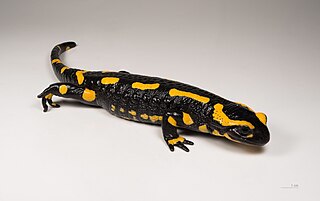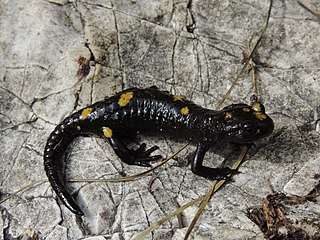
The Alps are the highest and most extensive mountain range system that lies entirely in Europe, stretching approximately 1,200 km (750 mi) across seven Alpine countries : France, Switzerland, Italy, Liechtenstein, Austria, Germany, and Slovenia.

Salamandridae is a family of salamanders consisting of true salamanders and newts. Salamandrids are distinguished from other salamanders by the lack of rib or costal grooves along the sides of their bodies and by their rough skin. Their skin is very granular because of the number of poison glands. They also lack nasolabial grooves. Most species of Salamandridae have moveable eyelids but lack lacrimal glands.

The fire salamander is a common species of salamander found in Europe.

The alpine salamander is a black salamander that can be found in the French Alps, and through the mountainous range in Europe. It is a member of the genus salamandra. Their species name, atra, may be derived from the Latin ater, meaning dull black. The salamanders' coloration has evolved over time, as some species are completely monochrome black and others have yellow spotting and marks. Their life expectancy is at least 10 years. There are four subspecies of the alpine salamander, with varied distribution and physical coloration. Unlike other salamanders, whose larvae are developed in water, the alpine salamander and its subspecies are a fully terrestrial species in life and gestation. They give birth to live young.

Chytridiomycosis is an infectious disease in amphibians, caused by the chytrid fungi Batrachochytrium dendrobatidis and Batrachochytrium salamandrivorans. Chytridiomycosis has been linked to dramatic population declines or extinctions of amphibian species in western North America, Central America, South America, eastern Australia, east Africa (Tanzania), and Dominica and Montserrat in the Caribbean. Much of the New World is also at risk of the disease arriving within the coming years. The fungus is capable of causing sporadic deaths in some amphibian populations and 100% mortality in others. No effective measure is known for control of the disease in wild populations. Various clinical signs are seen by individuals affected by the disease. A number of options are possible for controlling this disease-causing fungus, though none has proved to be feasible on a large scale. The disease has been proposed as a contributing factor to a global decline in amphibian populations that apparently has affected about 30% of the amphibian species of the world. Some research found evidence insufficient for linking chytrid fungi and chytridiomycosis to global amphibian declines, but more recent research establishes a connection and attributes the spread of the disease to its transmission through international trade routes into native ecosystems.

The alpine newt is a species of newt native to continental Europe and introduced to Great Britain and New Zealand. Adults measure 7–12 cm (2.8–4.7 in) and are usually dark grey to blue on the back and sides, with an orange belly and throat. Males are more conspicuously coloured than the drab females, especially during breeding season.

Batrachochytrium dendrobatidis, also known as Bd or the amphibian chytrid fungus, is a fungus that causes the disease chytridiomycosis in amphibians.

Chalcides lanzai, or Lanza's skink, is a species of skink, a lizard in the family Scincidae. The species is endemic to Morocco.

The Corsican fire salamander is a species of salamander in the family Salamandridae found only on the island of Corsica as an endemic species. In former times, this species was known as a subspecies of the widespread but continental-distributed fire salamander, which may appear quite similar.

The spectacled salamander is a species of salamander in the family Salamandridae.

The Apennine yellow-bellied toad is a species of toad in the family Bombinatoridae endemic to Italy. Its natural habitats are temperate forests, temperate grassland, swamps, freshwater marshes, intermittent freshwater marshes, arable land, pastureland, ponds, open excavations, irrigated land, and seasonally flooded agricultural land. It is threatened by habitat loss.

The Betic midwife toad or Sapo Partero Bético is a species of frog in the family Alytidae. It is endemic to mountainous in south eastern Spain. Its natural habitats are temperate forests, freshwater marshes, intermittent freshwater marshes, pastureland, ponds, and aquaculture ponds. It is threatened by habitat loss.

Batrachochytrium salamandrivorans (Bsal) is a pathogenic chytrid fungus that infects amphibian species. Although salamanders and newts seem to be the most susceptible, some anuran species are also affected. Bsal has emerged recently and poses a major threat to species in Europe and North America.

Salamandra atra aurorae is a subspecies of the alpine salamander Salamandra atra found in south-eastern Italian Prealps. It is often called the golden alpine salamander.

Salamandra atra pasubiensis is a subspecies of the alpine salamander Salamandra atra found in south-eastern Italian Prealps.

Speleomantes strinatii, the French cave salamander, North-west Italian cave salamander, or Strinati's cave salamander is a small species of salamander found in northwest Italy and southeast France. It is very similar in appearance to the Italian cave salamander, but has a paler belly.

The Socotran pipistrelle or Lanza's pipistrelle is an endangered species of vesper bat in the family Vespertilionidae. It is endemic to Socotra Island in Yemen, and is the only mammal thought to be endemic to the island.



















